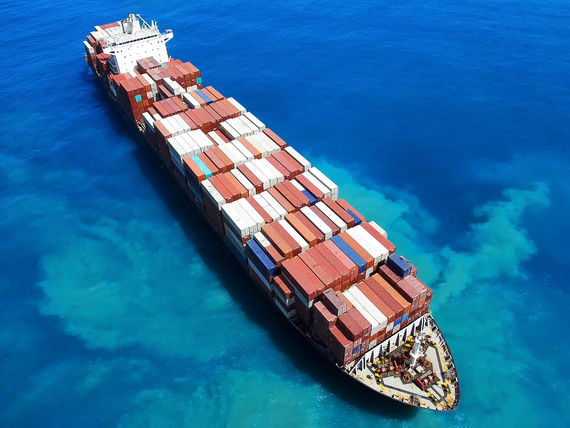Trendwatch: ILWU dockworkers Union’s sway at West Coast ports is tested in bankruptcy; IATA: First air cargo demand growth in 19 months; Panama Canal reduces the maximum number of ships travelling the waterway to 31 per day

ILWU dockworkers Union’s sway at West Coast ports is tested in bankruptcy
The West Coast dockworkers union’s bankruptcy filing puts a dent in the armor of one of the country’s most powerful labor groups, an organization that includes 22,000 members who handle virtually all U.S. seaborne trade from Seattle to San Diego.
The International Longshore and Warehouse Union filed for bankruptcy over the weekend to fend off a judgment holding it liable for what a federal jury found to be illegal slowdowns and work stoppages at Oregon’s Port of Portland.
An ILWU spokesman said the union will operate as normal “throughout the restructuring process.”
The union, which describes itself as democratic and militant, controls the hiring of dockworkers and their daily dispatch to work at cargo-handling terminals at 29 ports from Washington state to California. Its territory includes the nation’s busiest container port complex, at Los Angeles and Long Beach, the main gateway for imports of toys, clothes, electronics, furniture and consumer products from Asia.
IATA: First air cargo demand growth in 19 months
IATA has delivered some positive news for the airfreight industry with new data that shows year-on-year air cargo demand grew for the first time in 19 months, but it said the trajectory of global trade is a concern.
As part of its air cargo market analysis for August, the industry body noted that demand, measured in global cargo tonne-kilometers (CTKs) increased by 1.5% year on year (YoY) in August, the first annual growth since February 2022.
However, industry CTKs remained 1.3% lower than their pre-pandemic level in 2019.
Meanwhile, air cargo capacity, measured in available cargo tonne-kilometers (ACTKs), was up 12.2% year on year and 3.9% higher than 2019 levels.
Panama Canal reduces the maximum number of ships travelling the waterway to 31 per day
The Panama Canal announced Saturday it will reduce the maximum number of ships travelling the waterway to 31 per day, from 32 in August, due to a drought that has reduced the supply of fresh water needed to operate the locks.
That compares to daily averages of 36 to 38 ships per day under normal operation.
Nine ships per day will be allowed to use the new, bigger NeoPanamax locks and 22 per day will be handled through the older Panamax locks.
OPEC+ shows no sign of easing oil squeeze as ministers meet
As OPEC+ ministers prepare to review global oil markets, the group is showing no signs of cooling a rally that brought prices near $100 a barrel.
Crude has soared more than 20% in three months as alliance leaders Saudi Arabia and Russia squeeze supplies while world fuel demand hits records. The surge threatens to undermine a fragile global economy, harm consumers with another inflationary spike and derail central banks’ plans to wrap up interest-rate hikes.
Yet delegates from the Organization of Petroleum Exporting Countries and its partners don’t expect Wednesday’s meeting of the Joint Ministerial Monitoring Committee to recommend any policy changes. United Arab Emirates Energy Minister Suhail al Mazrouei said on Monday that OPEC+ has “the right policy.”
Declining box trades more attractive to car industry
Capacity and congestion in the car carrier sector have driven some freight forwarders and manufacturers to move cars in containers rather than delay exports until space becomes available.
Soaring freight rates, congestion and a lack of roro capacity have seen delays of up to three months or more in the shipment of cars as sky-high demand adds to the sector’s problems.
One freight forwarder who specialises in the handling of cars told Container News, “The cost of moving cars in containers is on a par with roro because although the freight is cheaper the cost of loading and unloading containers is greater.”
Ukraine defies Russia threat by trying to revive Black Sea trade
At least seven ships have completed journeys to major Ukrainian ports on the Black Sea without incident in the past few weeks, defying Russia’s threats to target vessels in the area.
The ships’ passage signals that Ukraine’s daring bet to set up its own trade route after the collapse of a safe-corridor agreed with Russia has paid off. So far the success is mostly symbolic, with ship traffic still requiring cautious maneuvers close to the coast of Bulgaria and Romania as vessels head to Ukraine.
Russia has previously threatened to treat any ships sailing to Ukraine as potentially carrying weapons, and in August opened fire on one to force it to stop for checks. In July, Russian President Vladimir Putin let lapse an agreement — brokered by Turkey and the UN — that allowed the safe passage of vessels exporting Ukrainian grains and other foodstuffs from three key Black Sea ports.


